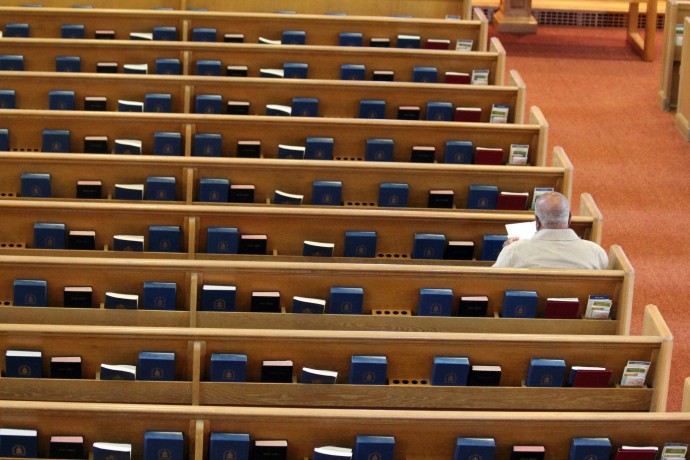If you’ve been following the story of Christianity in the United States with any degree of scrutiny, you’ll know that declension is not limited to liberal mainline denominations. The Catholic Church has been hemorrhaging white members left and right, a steep fall that is only evened out through immigration. The small, conservative Lutheran Church Missouri Synod has been losing people for a while, too.
Last month came word that the Southern Baptist Convention—the nation’s largest Protestant denomination, and one of its most conservative—has problems as well. The SBC had been almost flat on the membership charts for a number of years, but now it’s actually started to lose members.
In 2013, the SBC claimed 15,735,640 members, and in 2014, that number fell by 236,467 to 15,499,173—that’s a 1.5 percent decline. However, on this stat alone, the claim could be made that churches are simply clearing out the cobwebs and tidying up their membership rolls so their numbers more accurately reflect their active members.
The problem is, membership isn’t alone in its decline—it’s joined by baptisms and weekly worship attendance.
Whoops.
If anything, the analysis quoted above minimizes the problem. To understand why, you need to know something about geography. In short, they call it the Southern Baptist Convention for a reason. The church is centered in 11 southern states: Alabama, Arkansas, Georgia, Kentucky, Louisiana, Mississippi, Oklahoma, North and South Carolina, Tennessee and Texas. That won’t be a surprise to most Americans, but the extent to which the SBC depends on this “base” might be: since 1950, about 75-80 percent of the total membership has lived in those states. Texas alone makes up almost 20 percent of the total.*
And here the trouble begins. If you look at the rate of growth—not the total number of people joining, but the rate by which the church is growing—it tracks the rate of growth in the base states almost exactly.
With such a large proportion of the membership in the base states, this is about what you’d expect. In recent years, the decline in the overall growth rate has surpassed that in the base. In other words, they’re growing better in the core states than they are outside of them.
Actually, scratch that. The core is just about the only place the SBC is growing: between 1990 and 2010, the Convention added 955,000 members, 940,000 of whom came from their base states. (Of those, just less than 500,000 came from Texas.)
So it’s the angle in that yellow line that must give SBC executives sleepless night. Other than a brief upward tick in the ’80s, it’s been in steep decline. To make matters worse, since the mid-1990’s, it’s been in negative territory. Outside its geographic heartland, the SBC in 2010 was about the same size as it was in 1990. But it lost almost 50,000 members in Missouri alone in that time, another 45,000 in New Mexico, and Florida, 12,000 in Washington D.C.
Reading through the data, the conclusion seems inescapable: over the last half of the 20th century, the Southern Baptists enjoyed remarkable success in expanding out of their traditional turf. But in the early part of this century, that momentum stalled, and now they’ve started to give ground back.
Were it not for the growth in the SBC base—particularly in Texas—the church would have slipped into the red zone in the early 2000s, instead of last year.
Even at home, all is not good.
While growth was good in the 1970s and ’80s, growth among Southern Baptists outpaced that of the white population in their base states. Now that things have slowed down, the situation is reversed: southern whites are growing relatively faster than the church.
To be clear, this is not to say the Baptists benefitted from segregation or racism. It’s simply that, like many denominations, it’s an overwhelmingly white church. (The same could be said about my own United Church of Christ, even more so.) As the populations these denominations serve grew, denominations rose; but now that the white population is aging and shrinking, being replaced with a complex multi-racial society, those same churches struggle to adapt.
In the SBC’s case, that means as the South changes, it’s going to be tougher and tougher to keep their head above water. And if they’re flat in the homeland and falling outside it, it can mean only one thing: losses overall.
How to respond to this existential pickle? The leaders are talking about getting back to basics with evangelism and church starts. That leaves them basically with the options of figuring out how to appeal to the unchurched in the north or squeezing a few more folks out in the south.
Given that some leaders are calling for getting tougher on the doctrine, if not the SBC’s long-standing entanglement with conservative politics, the first option seems like a long shot. There are only slightly fewer than 500,000 Southern Baptists in California, for example, which sounds like a lot until you realize that it’s about 1 percent of the population.
In other places loaded with the religiously unaffiliated, such as Oregon or Washington state, the SBC is virtually unknown. It would take a tremendous amount of time, energy, and money to expand the church in places with rich potential for new converts. Even if the SBC were willing to make such an investment, it could struggle mightily to find a message that resonated with “nones” without offending the southern conservatives who make up the bulk of the denomination.
The other option isn’t without its difficulties, either. Unless Southern fertility rates change drastically, a new baby boom isn’t going to lift the boat. By now, new church start-ups in the base states run the risk of cannibalizing already-established communities.
And while the South changes more slowly than the rest of the country, it’s not immune to the rising tide of disaffiliation. That leaves reaching out to black folks and learning Spanish.
The Southern Baptist Convention will have to start looking like the millenial South if they want to stick around.
* I’m using data from The ARDA, which break down membership by state, but which apparently don’t match the SBC’s self-reported numbers. If anyone from the convention has state-level data they want to send me, I’ll gladly update the analysis.





